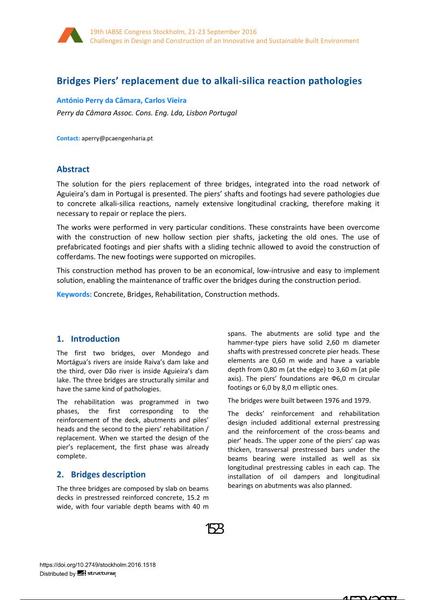Bridges Piers’ replacement due to alkali-silica reaction pathologies

|
|
|||||||||||
Détails bibliographiques
| Auteur(s): |
António Perry da Câmara
(Perry da Câmara Assoc. Cons. Eng. Lda, Lisbon Portugal)
Carlos Vieira (Perry da Câmara Assoc. Cons. Eng. Lda, Lisbon Portugal) |
||||
|---|---|---|---|---|---|
| Médium: | papier de conférence | ||||
| Langue(s): | anglais | ||||
| Conférence: | IABSE Congress: Challenges in Design and Construction of an Innovative and Sustainable Built Environment, Stockholm, Sweden, 21-23 September 2016 | ||||
| Publié dans: | IABSE Congress Stockholm, 2016 | ||||
|
|||||
| Page(s): | 1523-1529 | ||||
| Nombre total de pages (du PDF): | 7 | ||||
| Année: | 2016 | ||||
| DOI: | 10.2749/stockholm.2016.1518 | ||||
| Abstrait: |
The solution for the piers replacement of three bridges, integrated into the road network of Aguieira’s dam in Portugal is presented. The piers’ shafts and footings had severe pathologies due to concrete alkali-silica reactions, namely extensive longitudinal cracking, therefore making it necessary to repair or replace the piers. The works were performed in very particular conditions. These constraints have been overcome with the construction of new hollow section pier shafts, jacketing the old ones. The use of prefabricated footings and pier shafts with a sliding technic allowed to avoid the construction of cofferdams. The new footings were supported on micropiles. This construction method has proven to be an economical, low-intrusive and easy to implement solution, enabling the maintenance of traffic over the bridges during the construction period. |
||||
| Mots-clé: |
béton ponts
|
||||

